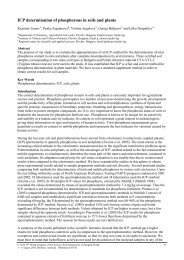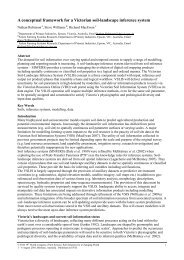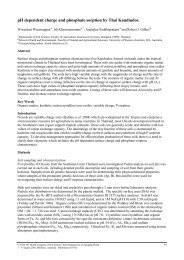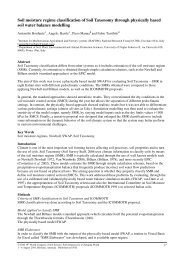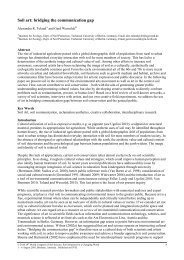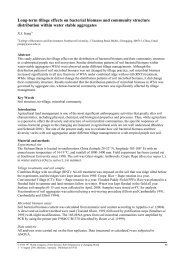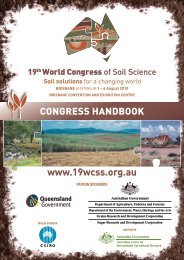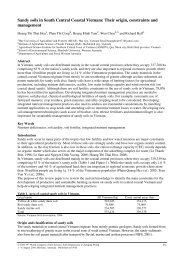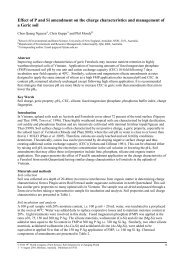Zwingmann Naoko - International Union of Soil Sciences
Zwingmann Naoko - International Union of Soil Sciences
Zwingmann Naoko - International Union of Soil Sciences
Create successful ePaper yourself
Turn your PDF publications into a flip-book with our unique Google optimized e-Paper software.
K from zeolite: glasshouse trial for testing K availability to the plants<br />
<strong>Naoko</strong> <strong>Zwingmann</strong> A , Robert J. Gilkes B , and Ian D.R. Mackinnon C<br />
A Rio Tinto Centre for Materials and Sensing in Mining, Curtin University <strong>of</strong> Technology, Bentley, WA, Australia, Email<br />
n.zwingmann@curtin.edu.au<br />
B School <strong>of</strong> Earth and Environment, The University <strong>of</strong> Western Australia, Crawley, WA, Australia, Email bob.gilkes@uwa.edu.au<br />
C Division <strong>of</strong> Research and Commercialisation, Queensland University <strong>of</strong> Technology, Brisbane, QLD, Australia, Email<br />
ian.mackinnon@qut.edu.au<br />
Abstract<br />
MesoLite, a zeolite material manufactured by NanoChem Holdings Pty Ltd is made by caustic reaction <strong>of</strong><br />
kaolin at temperatures between 80-95°C. This material has a moderate surface area (9~12 m 2 /g) and very<br />
high cation exchange capacity (500meq/100g). To measure the availability <strong>of</strong> K in K-MesoLite to plants,<br />
wheat was grown with K-MesoLite or a soluble fertiliser (e.g. KCl) in non-leached pots in a glasshouse. The<br />
weights and elemental compositions <strong>of</strong> the plants were compared after four weeks growth.<br />
Plants grown with K-MesoLite were slightly larger than those grown with KCl. The elemental compositions<br />
<strong>of</strong> the plants were similar except for Si, which was significantly higher in the plants grown with K-MesoLite<br />
than in those fertilised with KCl. K from K-MesoLite is readily available to plants.<br />
Key Words<br />
Zeolite from alkali modified kaolin, K-fertiliser, glasshouse experiment, wheat.<br />
Introduction<br />
The synthetic zeolite, known by the trade name MesoLite (Mackinnon, 1998) is designed to have a very high<br />
cation exchange capacity (CEC) <strong>of</strong> approximately 500 meq/100g and in particular, a high ammonium (NH 4 + )<br />
sorption capacity for removing NH 4 + from wastewater (Mackinnon et al. 2003; Thornton et al. 2007a, b) by<br />
cation exchange with K + . In our previous work (<strong>Zwingmann</strong> et al. 2009) we showed that NH 4 + was<br />
gradually released to soil solution from NH 4 + -MesoLite which suggests the potential <strong>of</strong> this material for use<br />
as a slow release fertilizer. We present results from a glasshouse experiment to measure the availability to<br />
plants <strong>of</strong> K + in K-MesoLite.<br />
Materials and Methods<br />
Materials<br />
Bassendean sand from Kwinana, 50 km south from Perth (Western Australia) was used for the glasshouse<br />
experiments. Bassendean sand (Pleistocene age) is a podsolised beach dune material present over much <strong>of</strong><br />
the Perth region. The sand consists almost entirely <strong>of</strong> quartz (Playford and Low 1972). The pH and EC <strong>of</strong><br />
Bassendean sand was 5.9 and 20 µS/cm (1:5 soil/DI water) respectively. Bassendean sand contained 0.28%<br />
<strong>of</strong> C and 0.05% <strong>of</strong> N. The K content was below detection limits.<br />
K-MesoLite (with exchangeable K cation) manufactured by NanoChem Holdings Pty Ltd by caustic reaction<br />
<strong>of</strong> kaolin at a temperature between 80° and 95°C (Mackinnon, 1998) was used as the trial fertiliser. The pH<br />
and EC <strong>of</strong> K-MesoLite was 11.3 and 4.23 mS/cm (1:5 solid/DI water) while pH and EC for the soil with K-<br />
MesoLite at the highest application rate were 6.3 and 23 µS/cm respectively. Detailed chemical analyses <strong>of</strong><br />
Bassendean sand and K-MesoLite are shown in Table 1. Detailed properties <strong>of</strong> K-MesoLite including the<br />
high exchange capacity in particular to NH 4 + are described in Mackinnon et al. (1998) and <strong>Zwingmann</strong> et al.<br />
(2009).<br />
Glasshouse experiment procedures<br />
<strong>Soil</strong> was air-dried and sieved to less than 4 mm. Basal nutrients (N as NH 4 NO 3 applied every two weeks)<br />
96.37 mg/kg soil, Ca as CaCl 2 40.91 mg/kg soil, Mg (as MgSO 4 ) 3.94 mg/kg soil, Zn (as ZnSO 4 ) 3.25 mg/kg<br />
soil, Mn (as MnSO 4 ) 2.04 mg/kg soil, Cu (as CuSO 4 ) 0.51 mg/kg soil, B (as H 3 BO 3 ) 0.12 mg/kg soil Co as<br />
CoSO 4 7H 2 O 0.08 mg/kg soil, Mo as Na 2 MoO 4 2H 2 O 0.08 mg/kg soil, S (as MgSO 4 , ZnSO 4 , MnSO 4 , CuSO 4 )<br />
34.20 mg/kg soil, Na (as Na 2 MoO 4 ) 0.04 mg/kg soil, P (as (NaPO 3 ) 6 20.50 mg/kg soil, Cl - as CaCl 2 72.44<br />
mg/kg soil and KCl (for control, KCl pots) maximum addition 81 mg/kg soil and K-fertiliser (K-MesoLite<br />
and KCl as soluble fertiliser for control treatments) were added to 1.2 kg soil, mixed and placed in 13 cm<br />
diameter black plastic non-leached pots. All nutrients were added once before sowing and the same amount<br />
© 2010 19 th World Congress <strong>of</strong> <strong>Soil</strong> Science, <strong>Soil</strong> Solutions for a Changing World<br />
1 – 6 August 2010, Brisbane, Australia. Published on DVD.<br />
198
<strong>of</strong> N also added two weeks after sowing. The application rates <strong>of</strong> K fertiliser were 0, 2.8, 5.6, 11, 23, 45, 89<br />
mg/kg soil. Treatments were undertaken in triplicate. Pots were watered the day before sowing with<br />
deionised water (DI water) at an amount corresponding to field capacity. Ten pre-germinated wheat<br />
(Triticum aestivum L.) seeds were sown per pot at the 1cm depth and the pots were placed in a glasshouse.<br />
The plants were watered every day with DI water to maintain the soils at 95 % <strong>of</strong> field capacity. The pots<br />
were randomized every day. At the two leaf stage, plants were thinned to five seedlings per pot by selecting<br />
the five most uniform plants. After three weeks post-emergence, plants were affected by fungus and all the<br />
pots were treated with fungicide. At 25 days post-emergence, the plants were cut at 5 mm above the soil and<br />
dried at 70 °C for weighing and elemental analysis.<br />
Analytical methods<br />
Elemental analyses were carried out by X-ray fluorescence spectrometry (Philips, PW 1730) on fused bead<br />
samples for Bassendean sand and K-MesoLite and on pressed pellets for plant material. Finely ground plant<br />
samples <strong>of</strong> approximately 0.3 g with 0.13 mL PVA solution as binder were mixed thoroughly and pressed on<br />
to a boric acid base at 350 bar using a Sietronics Autopress. Some plant samples had extremely low weights<br />
and were diluted with cellulose to make 0.3 g before pressing into a disc. C and N concentrations <strong>of</strong> the<br />
dried plant material were measured with a LECO CHN-1000 analyser. Due to the small amounts <strong>of</strong> plant<br />
material, XRF and C/N analysis were carried out on combined plant material from triplicate treatments.<br />
Results<br />
The weight <strong>of</strong> the plants increased with K fertiliser application rate. The plants grown with K-MesoLite with<br />
high application rate reached a higher yield plateau than those supplied with the soluble K fertiliser KCl.<br />
(Figure 1).<br />
3<br />
plant weight (g)<br />
2<br />
1<br />
0<br />
K-MesoLite<br />
KCl<br />
0 50 100<br />
K applied (mg/kg soil)<br />
Figure 1. The weight <strong>of</strong> plants versus the rate <strong>of</strong> K application.<br />
The concentration <strong>of</strong> K in the plants increased with K application rate and is similar for KCl and K-MesoLite<br />
(Figure 2a). Figure 2b is a plot showing the internal efficiency <strong>of</strong> K utilisation, i.e. the weight <strong>of</strong> plant<br />
material for the same amount <strong>of</strong> K in plant for the two fertilisers. The internal efficiency <strong>of</strong> K for the plants<br />
fertilised with K-MesoLite was higher than for plants fertilised with KCl where some factor other than K<br />
supply had limited yield.<br />
To identify this limiting factor concentrations <strong>of</strong> other elements in the plants are plotted against plant weight<br />
in Figure 3. The concentrations <strong>of</strong> N, P, S, Ca, Mg, Zn, and Cl in the plants fertilised with K-MesoLite are<br />
identical or similar with those fertilised with KCl. The concentrations <strong>of</strong> these elements are sufficient for<br />
maximum growth (Reuter and Robinson 1997). However Si was much more abundant in plants fertilised<br />
with K-MesoLite which evidently acts as a Si fertiliser, which is consistent with its Si rich composition and<br />
synthesis procedure that liberates Si from the kaolin structure.<br />
© 2010 19 th World Congress <strong>of</strong> <strong>Soil</strong> Science, <strong>Soil</strong> Solutions for a Changing World<br />
1 – 6 August 2010, Brisbane, Australia. Published on DVD.<br />
199
(a)<br />
3<br />
(b)<br />
3.0<br />
K % in plants<br />
2<br />
1<br />
0<br />
KCl<br />
K-MesoLite<br />
0 50 100<br />
K applied (mg/kg soil)<br />
yield (g)<br />
2.0<br />
1.0<br />
KCl<br />
0.0<br />
0.0 0.5 1.0 1.5<br />
K in plant (g)<br />
K-MesoLite<br />
Figure 2. The concentration <strong>of</strong> K in plants vs. K applied (a) and the internal efficiency <strong>of</strong> K use, i.e. the weight <strong>of</strong><br />
the plants (yield) vs. amount <strong>of</strong> K in plant.<br />
Figure 3. Element concentrations in plants vs. yield. The concentration <strong>of</strong> Si in plants fertilised with K-<br />
MesoLite is much higher than for plants fertilised with KCl.<br />
According to Ma and Yamaji (2008), Si influences plant growth through various mechanisms. In particular<br />
Ma et al. (2001) showed that Si protects plants from fungal disease thereby increasing yields. In the present<br />
experiment all plants were affected by a fungal disease after the third week. Plants fertilised with KCl were<br />
more severely affected by the fungal disease than those fertilised with K-MesoLite.<br />
© 2010 19 th World Congress <strong>of</strong> <strong>Soil</strong> Science, <strong>Soil</strong> Solutions for a Changing World<br />
1 – 6 August 2010, Brisbane, Australia. Published on DVD.<br />
200
Applied K is taken up by plants or remains in the soil for plants grown under non-leaching conditions. Much<br />
K remained in the soil at the end <strong>of</strong> the experiment (Figure 4a) with slightly more <strong>of</strong> the applied K from K-<br />
MesoLite being used by plants than for KCl at the higher rates <strong>of</strong> application (Figure 4b).<br />
100<br />
(a)<br />
100%<br />
(b)<br />
K (mg/kg soil)<br />
80<br />
60<br />
40<br />
soil<br />
plant<br />
80%<br />
60%<br />
40%<br />
soil<br />
plant<br />
20<br />
20%<br />
0<br />
0 2.8 5.6 11 23 45 89 2.8 5.6 11 23 45 89<br />
K as KCl (mg/kg soil)<br />
K as K-MesoLite (mg/kg soil)<br />
0%<br />
0 2.8 5.6 11 23 45 89 2.8 5.6 11 23 45 89<br />
K as KCl (mg/kg soil)<br />
K as K-MesoLite (mg/kg soil)<br />
Figure 4. The mass balance for applied K (a) and the percentages <strong>of</strong> K in plants and soil (b).<br />
Conclusion<br />
This glasshouse experiment showed that K from K-MesoLite was as available for plants as K supplied as<br />
KCl. The internal efficiency <strong>of</strong> K use by plants grown with K-MesoLite was higher than for plants fertilised<br />
with KCl. This difference can be related to the higher Si concentrations in plants fertilised with K-MesoLite<br />
enabling better resistance to fungal infection.<br />
Acknowledgement<br />
We thank Mr. Michael Smirk (SEGS, UWA), Mr. Leon Hodgson (Glasshouse technician, UWA) Mr. Paul<br />
Damon (Plant Nutrition Group) for their assistance. We thank NanoChem Holdings Pty. Ltd. for materials<br />
and funding. This study was funded by the Australian Research Council.<br />
References<br />
Ma JF, Miyake Y, Takashashi E (2001) Silicon as a beneficial element for crop plants. In ‘Silicon in<br />
agriculture’. (EDs LE Datn<strong>of</strong>f, GH Snyder, GH Korndörfer) pp. 17-39. (Elsevier, Amsterdam).<br />
Ma JF, Yamaji N (2008) Review- Functions and transport <strong>of</strong> silicon in plants. Cellular and Molecular Life<br />
<strong>Sciences</strong>. 65, 3049-3057.<br />
Mackinnon IDR (1998) Value-added products from modified kaolins: New chemical routes to new markets.<br />
Industrial Minerals, 138-146.<br />
Mackinnon IDR, Barr K, Miller E, Hunter S, Pinel T (2003) Nutrient removal from wastewaters using high<br />
performance materials. Water Sci. and Tech. 47(11), 101-107.<br />
Playford PE, Low GH (1972) Definitions <strong>of</strong> some new and revised rock units in the Perth Basin. West<br />
Australian Geological Survey Annual Report 1971, 44–46.<br />
Reuter DJ, Robinson JB (Eds.) (1997) Plant analysis: an interpretation manual. 2nd edition. CSIRO<br />
Publishing. Collingwood. 572pp.<br />
Thornton A, Pearce P, Parsons SA (2007a) Ammonium removal from digested sludge liquors using ion<br />
exchange. Water Research 41, 433–439.<br />
Thornton A, Pearce P, Parsons SA (2007b) Ammonium removal from solution using ion exchange on to<br />
MesoLite, an equilibrium study. Journal <strong>of</strong> Hazardous Materials 147, 883-889.<br />
<strong>Zwingmann</strong> N, Singh B, Mackinnon IDR, Gilkes RJ (2009) Zeolite from alkali modified kaolin increases<br />
NH 4 + retention by soil: column experiments. Applied Clay <strong>Sciences</strong> 46, 7-12.<br />
© 2010 19 th World Congress <strong>of</strong> <strong>Soil</strong> Science, <strong>Soil</strong> Solutions for a Changing World<br />
1 – 6 August 2010, Brisbane, Australia. Published on DVD.<br />
201



